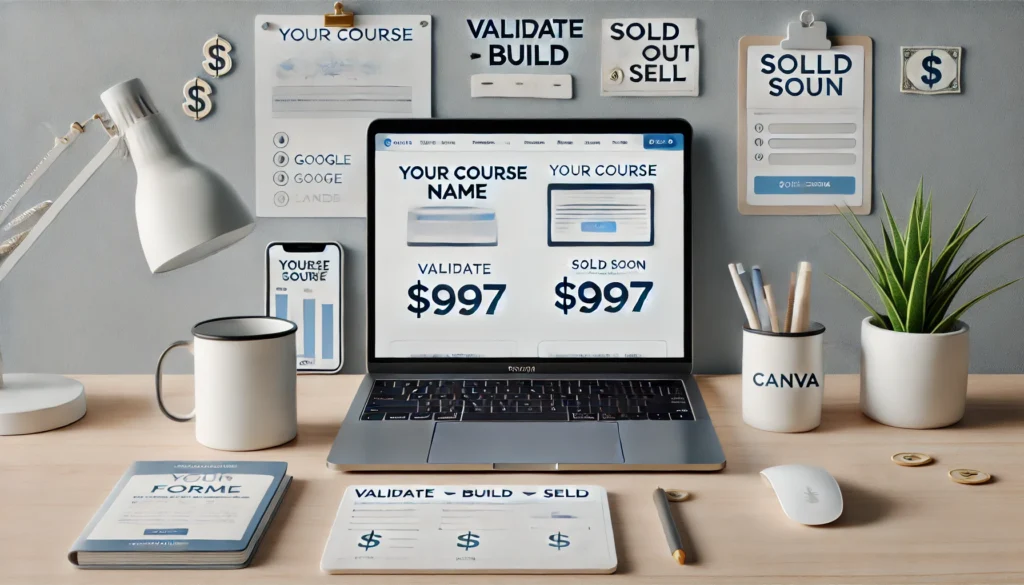You’ve been told you need a fancy studio, a $5k budget, and a massive audience to sell online courses. Lies. All of them.
I spent six months recording 4K videos, designing “perfect” slides, and begging my 200 email subscribers to buy my $197 course. Total sales? Zero. Then I stripped everything back, used free tools, and launched a $197 course. Total sales? Zero. Then I stripped everything back again, used free tools, and launched a $997 course in 72 hours. It sold 12 copies in the first week.
If you’re drowning in over complicated advice, this guide will show you:
- How to validate your course idea in 1 hour (no audience required).
- The exact free tools to build a high-value course without tech skills.
- Psychological pricing tricks to justify $997 (even if you’re a “nobody”).

Why Traditional Course Creation Fails (And How to Hack It)
Kajabi’s 2023 data reveals 92% of first-time course creators quit—not due to lack of expertise, but overwhelm. Here’s why the old model is broken:
- Overproduced Content:
- Fancy intros, 4K b-roll → Costs $5k, adds zero value.
- Platform Obsession:
- Investing in Thinkific/Kajabi before validating demand → Wasted cash.
- Audience Myth:
- “You need 10k followers” → False. Micro-communities convert better.
The Fix: Minimum Viable Product (MVP) Method → Build fast, validate, then scale.
Case Study: The Postpartum Core Reset That Sold Out
A fitness coach with 500 Instagram followers:
- Step 1: Posted a Google Form in 3 Facebook mom groups.
- Step 2: 50 responses → “Postpartum Core Reset” course idea validated.
- Step 3: Built with Canva + Loom → Sold 8 courses at $997 in 10 days.
Step 1: Validate Your Idea in 1 Hour (No Audience Needed)
Forget paid ads. Use free communities to test demand:
Tool 1: Google Forms
- Where to Post:
- Niche Subreddits (e.g., r/Entrepreneur, r/NewParents).
- Facebook Groups (search “[your niche] + support”).
- Ask This:
- “What’s your #1 struggle with [topic]?”
- “Would you pay $X for a solution?”
Tool 2: Canva Mock Landing Page
- Template: “Coming Soon: [Course Name]” → Add 3 bullet points.
- Track Interest: Use Google Analytics to monitor page views.
- Example:
“The 3-Day Blog-to-Book Blueprint” – Turn old posts into a book draft. – Publish on Amazon KDP. – Pre-order now (50% off for first 10).
Pro Tip: Offer a “discount for feedback” to early respondents.
Step 2: Build the Course with Free Tools (No Tech Wizardry)
Repurpose, Don’t Reinvent:
- Turn blog posts into video scripts.
- Use podcast episodes as Q&A modules.
Free Stack:
- Hosting: Teachable Free Plan (up to 10 students).
- Design: Canva for PDFs/workbooks.
- Video: Loom (free screen recorder).
MVP Course Template:
Module 1: [Core Problem] → 10-min Loom video + blog post PDF.
Module 2: [Solution] → Checklist + case study (steal from Reddit).
Module 3: [Bonuses] → 1-hour live Q&A replay (record via Zoom).
Example: A blogger transformed three posts on “SEO for Beginners” into a $997 course → $8K in 2 months.
FAQs: Your Course Roadblocks, Solved
Q: “What if I have no audience?”
A: Partner with micro-influencers (1k-10k followers) for a 50/50 revenue split.
Q: “How do I handle payments without a website?”
A: Use PayPal Invoices or Gumroad (no upfront fees, instant payouts).
Q: “Can I charge $997 with no credentials?”
A: Yes! Position as “exclusive access” → “Only 10 spots at this price.”
Tomorrow’s Teaser:
“Day 19: How to Land Your First Paying Client (Cold Email Templates)”
- Sneak Peek: 4 email scripts to land clients without experience.
- Freebie: “Freelance Pitch Database”.
CTA: “Ready to quit unpaid gigs? Save this post—tomorrow’s guide gets you paid. Must read this blog.”
